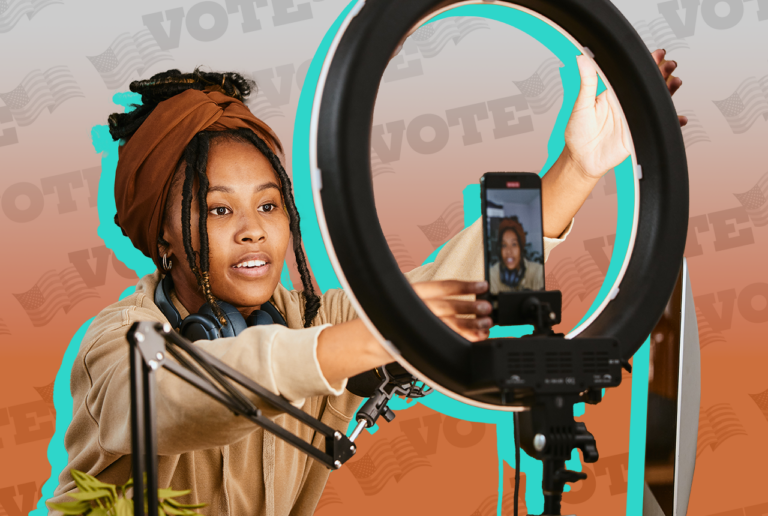The Risks and Rewards of Using Influencers to Get Out the Vote

Since the 2016 election cycle, social media influencers have played an increasingly important role in shaping political narratives and reaching new audiences.
As platforms like TikTok, Meta (Facebook and Instagram), YouTube, and X (Twitter) continue to change and, in many ways, reduce what can be done with traditional political advertising, campaigns and advocacy organizations are turning to influencers to persuade and mobilize targets like young voters, infrequent voters of color, and voters in battleground states.
These influencers are often viewed as more genuine, more engaging, and more likely to curry favor with voters, allowing politicians who openly embrace them to expand their reach to new audiences. In 2023, following the collapse of a bridge on 1-95 in Philadelphia, TikTok influencer Pearlmania500 was invited to press events for Pennsylvania Governor. Josh Shapiro and President Biden to post about the bridge’s reopening and the Biden Infrastructure plan. The Philadelphia-based influencer and podcaster has built a brand commenting on political news and trending topics that primarily impact voters in Pennsylvania, but he’s also expanded his niche to comment on national political issues. More recently, Governor Shapiro also appeared on an episode of the “Between Us Girlies” podcast co-hosted by Philadelphia content creator influencer, @bran__flakezz.
Likewise, the Biden/Harris team hosted popular beauty and lifestyle influencer Clarke Peoples and others for a GOTV briefing in New York City to discuss tactics for energizing youth turnout during this fall’s general election. By inviting the influencers to “spend the day with them” the Biden/Harris campaign was able to boost their campaign’s profile with younger communities of color, while also highlighting the issues that the campaign is focused on most.
However, as influencers continue to become popular campaign surrogates and catalysts for voter engagement, are campaigns able to actually measure the effectiveness of these tactics? In 2022, despite strong investment in influencer partnerships, youth voter turnout was still lower than previous years, with voters under 50 representing just 36% of the electorate in 2022 compared to 40% in 2014 according to Pew Research Center.
Additionally, while voters tend to view influencers as more authentic than typical campaign surrogates, the credibility and trust placed in these influencers by their followers have also become a subject of debate, as fans have started to question the motives behind their collaborations with political campaigns.
So how do you leverage influencers strategically and helpfully in your campaign?
Disclose the arrangement upfront
We’ve seen, especially recently, that influencers are likely to be called out by other social media users for their advocacy, and if it’s not disclosed upfront it can lead to followers feeling betrayed and let down by their favorite creators. Disclosing partnerships upfront builds trust through transparency and avoids immediate or delayed backlash.
Align your message and your audience
Influencers are popular when their content reflects the sentiments of their audience. Many pro-Biden influencers from the 2020 and 2022 cycles have moved further to the left, and have been actively sharing their disappointment of the current administration with their followers. You need to do your due diligence and research before approaching an influencer – just because their content worked last cycle does not guarantee they are interested in helping or really able to.
Stay on top of Big Tech regulations
Platforms like TikTok and Meta have heavy restrictions on political advertising, and paid influencers are often seen as a workaround to this issue, but it poses concerns about transparency and ethics. According to this 2022 New York Times article, the Federal Election Commission estimates that over $300 million was allocated to digital ads (including social media advertising) throughout the midterm election cycle, however, there’s no way to identify exactly how much was spent on influencer advertising. As more campaigns on both the right and the left continue to find loopholes to engage influencers for political ads, Big Tech leaders remain concerned about the role that undisclosed political advertising will play in upcoming elections.
Despite the potential downsides, we know social media and influencer content is still important for helping campaigns and political groups grow awareness with young voters, as most Millennials and Gen Z audiences get their news from social media instead of traditional media outlets. As campaigns continue to reflect on the benefits and drawbacks of leveraging content creators and influencers to reach voters, the need to partner with trusted and experienced firms that know how to navigate this landscape will be a crucial determinant in their success for 2024.
>> REACH OUT TO US to learn more about Precision’s influencer marketing capabilities and how we can partner together.
 Mia Logan is a Senior Vice President on Precision’s digital team. As a digital strategist and paid media subject matter expert, she has over a decade of multi-disciplinary experience in planning, implementing and executing campaigns for nonprofit, corporate, government, entertainment, tech and political advocacy organizations. Prior to rejoining Precision, Mia worked as the Vice President of Digital at Fenton Communications where she led digital strategy for client accounts like Bloomberg Philanthropies, Stop AAPI Hate, PricewaterhouseCoopers (PwC) and the NYC Votes. In addition to her work in the social impact space, Mia has also led online and offline advertising campaigns for clients like the National Trust for Historic Preservation, The Obama Foundation, the NFL Players Association, the League of Women Voters, the Center for Disease Control, Taco Bell, TIDAL, Oxford University Press and more.
Mia Logan is a Senior Vice President on Precision’s digital team. As a digital strategist and paid media subject matter expert, she has over a decade of multi-disciplinary experience in planning, implementing and executing campaigns for nonprofit, corporate, government, entertainment, tech and political advocacy organizations. Prior to rejoining Precision, Mia worked as the Vice President of Digital at Fenton Communications where she led digital strategy for client accounts like Bloomberg Philanthropies, Stop AAPI Hate, PricewaterhouseCoopers (PwC) and the NYC Votes. In addition to her work in the social impact space, Mia has also led online and offline advertising campaigns for clients like the National Trust for Historic Preservation, The Obama Foundation, the NFL Players Association, the League of Women Voters, the Center for Disease Control, Taco Bell, TIDAL, Oxford University Press and more.